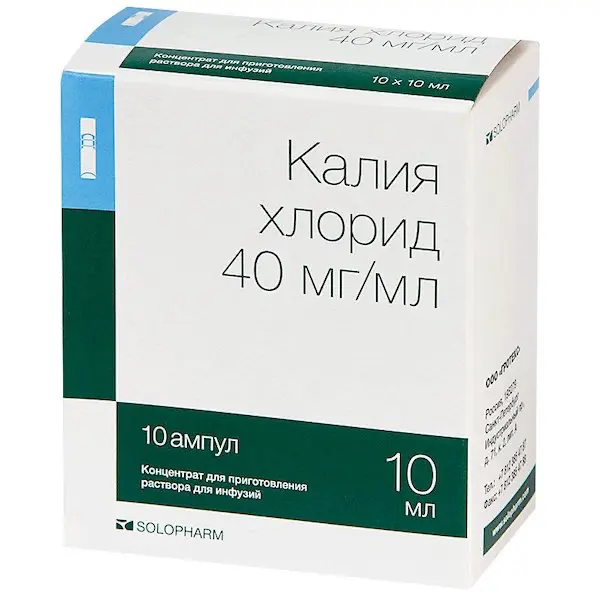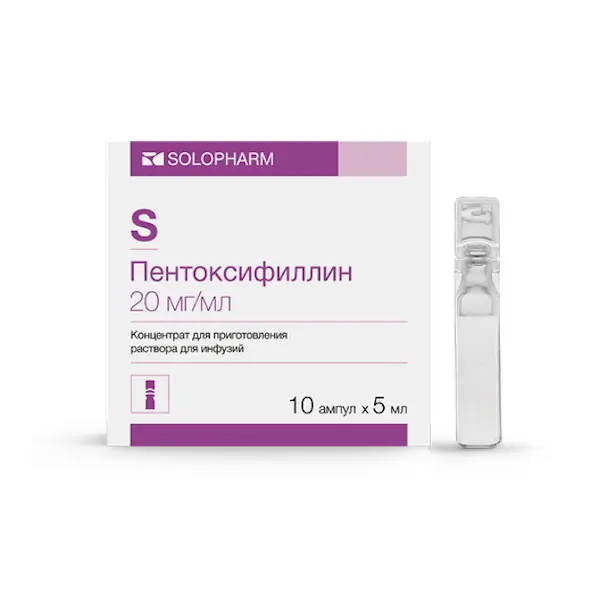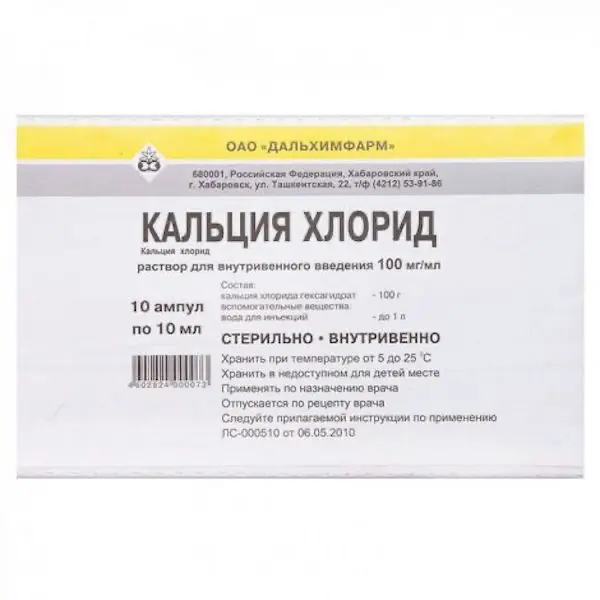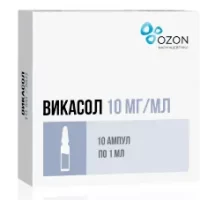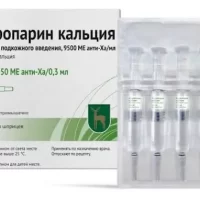Description
Potassium chloride Pharmacodynamics
Mechanism of action
Potassium is the most important intracellular cation, about 98% of the total potassium content in the body is in the intracellular fluid. Potassium is involved in the electrochemical processes of the cell, as well as in carbohydrate and protein metabolism. During glycogen and protein synthesis, potassium is consumed by cells, and during breakdown of these substrates, potassium is released (about 0.4-1 mmol potassium/g glycogen and about 2-3 mmol potassium/g excreted nitrogen).
Therapeutic effect
The therapeutic effect of intravenous potassium chloride solutions is to prevent or treat potassium deficiency when oral administration (or enteral administration) is impossible or insufficient. The daily requirement for potassium is about 1-1.5 mmol/kg body weight. Potassium deficiency can be caused by increased renal excretion, increased losses through the gastrointestinal tract, such as in vomiting, diarrhea or through fistulas, increased intracellular intake, such as with treatment of acidosis or administration of dextrose and insulin, and insufficient potassium intake. Hypokalemia is accompanied by muscle weakness, gastrointestinal smooth muscle atony (from constipation to intestinal obstruction), loss of renal urine concentration capacity, ECG changes and cardiac arrhythmias.
Indications
Hypokalemia of various genesis, including arrhythmias caused by hypokalemia.
Contraindications
Hypersensitivity to the components of the drug, hyperkalemia or hyperchloremia of any etiology, complete atrioventricular or intraventricular block, renal failure with oliguria or azotemia, ventricular fibrillation, Addison’s disease, hyperadrenalism associated with adrenogenital syndrome, extensive tissue decomposition (including severe burns and burns of the skin). including severe burns), acute dehydration, heat seizures, conditions with hypersensitivity to potassium administration (including hereditary episodic adynamia or congenital paramyotonia), concomitant therapy with potassium salts and potassium-saving diuretics.
Caution:
Grade I-II atrioventricular block, heart failure, sickle cell anemia, diseases and conditions accompanied with impaired potassium excretion, including chronic renal failure, adrenal insufficiency. In patients taking cardiac glycosides, aldosterone antagonists, ACE inhibitors, tacrolimus, cyclosporine, long-acting heparin, suxamethonium or potentially nephrotoxic drugs (nonsteroidal anti-inflammatory drugs, peripheral analgesics).
Pregnancy and lactation:
Caution should be exercised when prescribing the drug to pregnant women. The drug should be used only with obvious indications for its use, if the expected benefits to the mother exceed the potential risk to the fetus (if possible, oral potassium preparations are prescribed). Potassium is excreted with the breast milk. Caution should be exercised when prescribing the drug to breastfeeding women (if possible, oral potassium preparations should be prescribed).
Dosage and administration method
- The drug is administered intravenously by drip. If possible, it is necessary to prescribe oral potassium preparations, especially in children.
- Dosage for treatment of potassium deficiency should be chosen according to actual concentration of electrolytes in blood plasma and acid basic state indicators.
- Dose for treatment of moderate, asymptomatic potassium deficiency and for maintenance therapy:
The amount of potassium required to correct moderate potassium deficiency and in maintenance therapy can be calculated using the following formula:
Required amount of mmol K+ = (MT*[kg] x 0.2)** x 2 x (target plasma K+ concentration *** – actual plasma K+ concentration [mmol/L]
Where:
*MT = body weight;
**Value represents extracellular fluid volume;
***the target plasma K+ concentration should be 4.5 mmol/L. - In hypokalemia with cardiac rhythm disorders – 1-1.5 g 4-5 times per day; after cardiac rhythm recovery the dose is reduced.
- For stopping paroxysmal tachycardia attacks on the first day 8-12 g, with subsequent reduction to 3-6 g.
- The solution is administered intravenously by drop-flow at a rate of up to 2.5 g of potassium chloride in 500 ml of 0.9% isotonic sodium chloride solution or 5% dextrose solution.
- Dextrose solution is not used at the beginning of hypokalemia therapy, as it may lead to decrease of potassium concentration in blood.
- For prevention and treatment of ectopic arrhythmias in myocardial infarction a polarizing mixture is used: potassium chloride solution of 2-2.5 g in 500 ml of 5%-10% dextrose solution (short-acting insulin is added at the rate of 1 NA per 3-4 g of dry dextrose). The resulting solution is administered intravenously by drip at a rate of 20-30 drops per minute. The rate of administration should not exceed 1.5 g per hour. In severe hypokalemia or ketoacidosis, a higher infusion rate may be required, which should be accompanied by obligatory ECG monitoring.
- In children with body weight less than 25 kg and newborns daily dose should not exceed 0.225 g/kg of body weight. For children with body weight over 25 kg, doses correspond to those for adults.
- Procedure of work with polymeric ampoule:
– Take the ampoule and shake it by holding the neck.
– Squeeze the ampoule by hand, making sure that the drug does not release, and with a rotating movement turn and separate the valve.
– Immediately connect the syringe to the ampoule through the resulting opening.
– Turn the ampoule over and slowly draw the contents into the syringe.
– Slide the needle onto the syringe.

